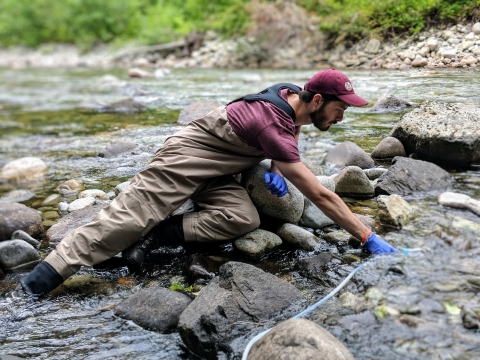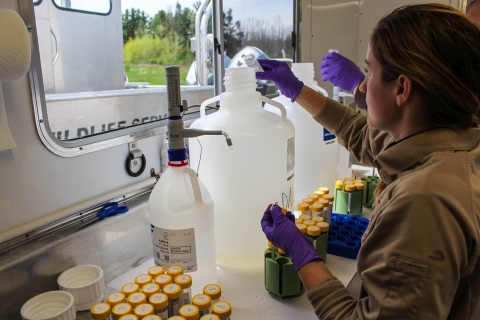Have you ever wondered how scientists figure out what’s living in our lakes, rivers, and oceans? Unlike the animals that we can see in the air or on land, the fish and other wildlife that live in our oceans and rivers can seem mysterious and often invisible. But that doesn’t have to be the case. It turns out that living creatures can leave behind clues in the form of genetic “footprints” in the water. With the right tools, we can use a small sample of water to see what’s living beneath the surface.
Skin, scales, and scat
Environmental DNA, or eDNA for short, is a tool that can be used to monitor the presence of a species in the water, on land, or even in the air. This emerging technology looks for DNA that has been “shed” into the environment from skin cells, scales, or waste.
U.S. Fish and Wildlife (Service) biologists use eDNA monitoring to detect invasive, imperiled, or rare species. It can also be used to better understand how species are using habitat, what their movement patterns are, and provide early detection of their spread from one system to another. This information, when paired with other ways of monitoring, helps natural resource professionals make scientifically informed decisions about how to protect native species and their habitats.
In June 2024, the White House Office of Science, Technology, and Policy released the ‘National Strategy for Aquatic Environmental DNA’, a plan to harness the power of eDNA to explore, map, monitor and better understand aquatic life in order to sustain and restore biological resources now and in the future.
National Strategy for Aquatic Environmental DNA
The strategy was compiled by an interagency eDNA Task Team that included Service biologists and more than 100 scientists and experts from 24 agencies and programs across the federal government. Through broad engagement, it paves the way for a collaborative and united effort to document and monitor the biodiversity of our marine and freshwater environments.
The strategy also calls on federal agencies and non-federal partners to build upon our shared successes and invest in expanded capacities to unite scientific inquiry, entrepreneurial enterprise, philanthropic endeavor, and public and private investment.
Tracking genetic footprints to save fish and wildlife
For over a decade the Service has been pioneering genetics research to benefit the conservation of fish, wildlife, and plants. The Service’s Fish and Aquatic Conservation program currently operates three eDNA labs as part of a national network of conservation genetics and applied science facilities and is expanding that capacity to meet the growing needs of natural resource managers.
These labs develop standard operating protocols and best practices for all phases of eDNA projects and provide trainings on eDNA technology for conservation partners. This expertise drives the Service’s role as a leader in large-scale, national eDNA efforts.
A major focus of the Service’s eDNA expansion is a collaborative effort with other agencies within the Department of the Interior on the National Early Detection and Rapid Response Framework (EDRR Framework) funded in large part by the Bipartisan Infrastructure Law Bipartisan Infrastructure Law
The Bipartisan Infrastructure Law (BIL) is a once-in-a-generation investment in the nation’s infrastructure and economic competitiveness. We were directly appropriated $455 million over five years in BIL funds for programs related to the President’s America the Beautiful initiative.
Learn more about Bipartisan Infrastructure Law .
The EDRR Framework is a coordinated interagency effort to identify and respond to new invasive species invasive species
An invasive species is any plant or animal that has spread or been introduced into a new area where they are, or could, cause harm to the environment, economy, or human, animal, or plant health. Their unwelcome presence can destroy ecosystems and cost millions of dollars.
Learn more about invasive species as quickly as possible to prevent their establishment and spread. The EDRR Framework includes expanded eDNA monitoring and processing capacity, the development of a molecular lab network, eDNA marker development, and invasion hotspot identification and surveillance in collaboration with local agencies and organizations.
From mussels to moss balls
In addition to the EDRR Framework, the Service is working with partners to deploy eDNA monitoring for both native and invasive species across the country to help inform our conservation efforts.
- Scientists at our Northeast Fishery Center and Whitney Genetics Lab process thousands of eDNA samples each year to detect invasive fish species in the Great Lakes and are developing a comprehensive genetics reference database for native species of the Great Lakes. The reference database, which is now nearly 98% complete and combined with DNA sequences from fish around the world will allow geneticists to produce lists of species from lake samples they receive, revealing any fish that doesn’t belong.
- The Service is working with the U.S. Geological Survey to conduct early detection of invasive mussels through rapid eDNA testing of imported specimens of moss balls, which have recently been found to be a pathway for zebra mussel spread in the United States.
- The Service operates one of the largest and longest running eDNA programs for natural resource management, the invasive carp monitoring program, adopted in 2013.
- The Service is working with USGS and the US Air Force to validate existing eDNA markers for Alligator Snapping Turtles and develop eDNA monitoring tools for the species on Air Force installations.
- The Service is working with state and other partners to develop eDNA tools for monitoring federally listed threatened and endangered species including Topeka Shiner, Dwarf Wedgemussel, Yellow Lance Mussel, and a variety of other species.
- The Service is conducting eDNA monitoring for invasive species including Northern Snakehead, Round Goby, Blue Catfish, and Northern Pike.
About the eDNA task team
The strategy was released by White House Office of Science, Technology, and Policy (OSTP), and created by the eDNA Task Team of the Subcommittee on Ocean Science and Technology (SOST), part of the Committee on Environment of the National Science and Technology Council. The eDNA Task Team had 15 federal agencies participating in drafting the Strategy, and included significant scoping and engagement of the private sector, academia and non-profit organizations.






